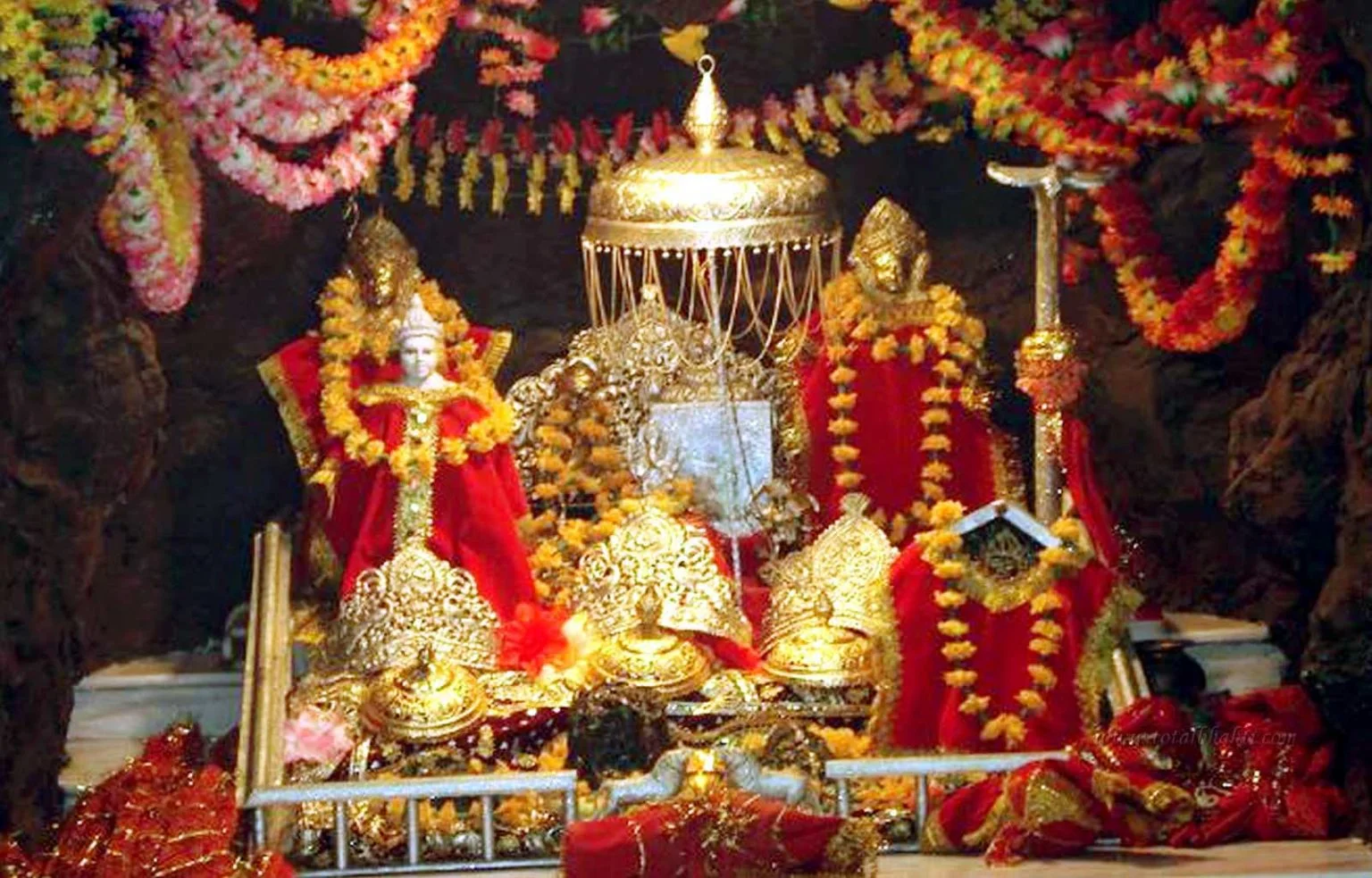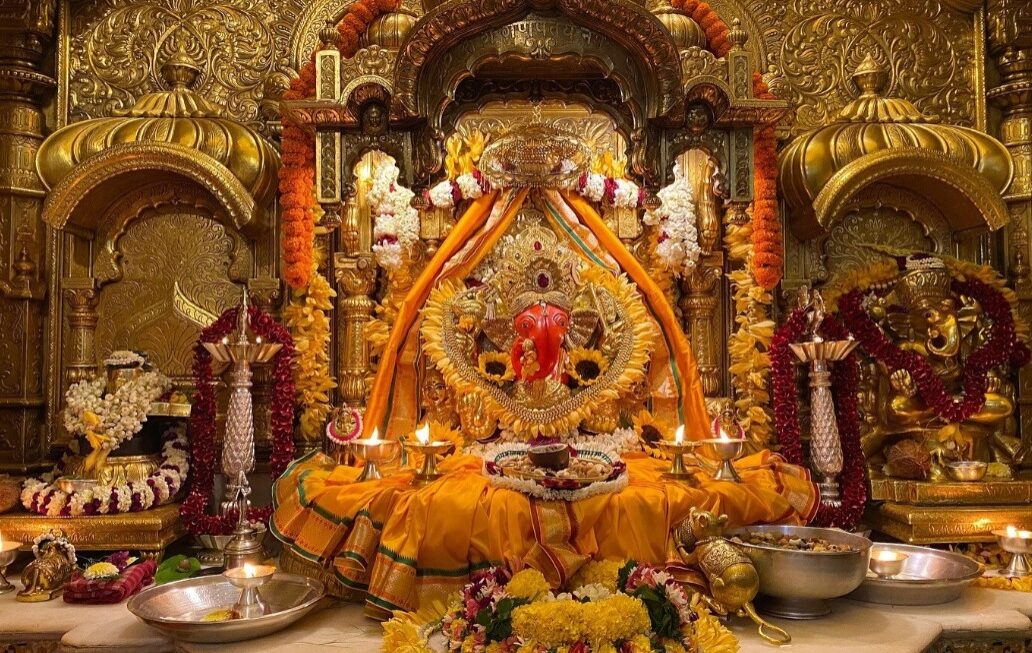It is said that Bhairo Nath, a famous Hindu Tantric, saw the young Vaishno Devi at an agricultural fair and fell madly in lusty love with her.
The Vaishno Devi Temple, nestled in the Triputa Mountains of Jammu and Kashmir, is a revered pilgrimage site attracting millions of devotees annually. Legend has it that Goddess Vaishno Devi, an incarnation of Goddess Durga, appeared in the form of a young girl named Triputa. She performed intense penance in these mountains, seeking Lord Vishnu as her consort. Impressed by her devotion, Lord Vishnu granted her the boon to be worshipped as Vaishno Devi, a manifestation of his energy…
Pilgrims embark on a 14-kilometer trek from Katra to the sanctum, chanting “Jai Mata Di” amidst picturesque landscapes. The journey symbolizes faith and endurance, culminating in the darshan of the Goddess, believed to fulfill devotees’ wishes and bestow blessings. The temple’s rich history and spiritual significance continue to inspire millions, making it a cornerstone of Hindu devotion.
During the feast, Bhairon Nath demanded meat and alcohol, which were against the sanctity of the occasion. When denied, he became enraged and pursued the young girl, unaware she was the divine Vaishno Devi. She fled into the Trikuta Mountains, halting at various spots now known as Banganga, Charan Paduka, and Ardh Kunwari. At Ardh Kunwari, she meditated in a cave for nine months. When Bhairon Nath discovered her, she assumed the form of Goddess Chamunda and beheaded him. His head fell at a distant hilltop, where the Bhairon Nath Temple now stands. Before dying, Bhairon Nath sought forgiveness, and the compassionate Goddess granted him liberation, decreeing that devotees must visit his temple to complete their pilgrimage.
Another legend speaks of the origin of Vaishno Devi herself. It is believed that the three primary manifestations of the Mother Goddess—Maha Kali, Maha Lakshmi, and Maha Saraswati—pooled their collective spiritual strength, resulting in a brilliant light from which a beautiful young girl emerged. This girl was named Vaishnavi, who later performed intense penance in these mountains, seeking Lord Vishnu as her consort. Impressed by her devotion, Lord Vishnu granted her the boon to be worshipped as Vaishno Devi, a manifestation of his energy.
The Vaishno Devi Temple, located in the Trikuta Mountains of Jammu and Kashmir, is accessible to pilgrims throughout the year. However, the experience of the pilgrimage can vary significantly depending on the season.
Summer (March to June): During these months, temperatures range from 15°C to 30°C, offering pleasant weather for the trek. This period is ideal for darshan (puja), providing a comfortable experience. It is advisable to carry light woolen clothes as evenings can be cooler due to the high altitude.
Monsoon (July to September): The region receives moderate to heavy rainfall during this period, with temperatures fluctuating between 17°C and 30°C. The lush greenery and cascading waterfalls enhance the natural beauty of the area. However, the risk of landslides makes the trek potentially hazardous, and it is generally recommended to avoid the pilgrimage during this season.
Autumn (September to November): These months are considered the peak season for Vaishno Devi darshan due to festive celebrations. Navratri and Dussehra, dedicated to honoring the power and glory of Goddess Durga/Chandi, see the highest influx of pilgrims. This period also offers breathtaking views of the surrounding landscape.
Winter (December to February): Temperatures during winter can drop significantly, ranging from -1°C to 10°C, with occasional snowfall. The snow-covered mountains provide a serene ambiance, but the cold weather can make the trek challenging. Pilgrims during this time should be prepared for harsh conditions and carry appropriate winter clothing.
In summary, the most favorable times to visit the Vaishno Devi Temple are during the summer and autumn months, specifically from March to June and September to November. These periods offer mild and pleasant weather, enhancing the overall pilgrimage experience.
Embarking on the Vaishno Devi pilgrimage is a profound spiritual journey that traditionally encompasses visits to several sacred sites, each holding its own significance. Here’s an overview of the key temples and spots that devotees typically include in their yatra:
1. Vaishno Devi Bhawan: The primary destination of the pilgrimage, the Bhawan houses the sacred cave where Mata Vaishno Devi is enshrined in the form of three natural rock formations, known as the Pin dies, representing the Goddesses Mahakali, Mahalakshmi, and Maha Sarasvati
2. Ardhi Kuwari (Adhkuwari) Cave: Located about halfway along the trek from Katra to the Bhawan, Ardh Kuwari is a revered site where Mata Vaishno Devi is believed to have meditated for nine months. Pilgrims often visit this cave to pay their respects and experience its spiritual ambiance.
3. Bhairo Nath Temple: Situated approximately 1.5 to 2 kilometers uphill from the Bhawan, this temple is dedicated to Bhairo Nath. According to legend, visiting this temple is considered essential to complete the pilgrimage, as it symbolizes seeking forgiveness and ensuring the yatra’s fulfillment.
4.Banganga: The starting point of the trek, Banganga holds significance as the place where Mata Vaishno Devi is said to have created a stream of water by shooting an arrow into the ground to quench her thirst. Pilgrims often take a ritual bath here before commencing their journey.
While visiting the Bhawan is the primary objective, incorporating these additional sites enriches the spiritual experience and aligns with traditional practices associated with the Vaishno Devi pilgrimage.
5.Charan Paduka: This sacred spot, en route to the Bhawan, is believed to bear the imprints of Mata Vaishno Devi’s feet. Devotees stop here to offer prayers and seek blessings.
Embarking on the pilgrimage to Vaishno Devi transcends a mere physical journey; it is a profound spiritual odyssey that intertwines faith, devotion, and the quest for divine communion. Nestled within the Trikuta Mountains of Jammu and Kashmir, the sacred shrine of Mata Vaishno Devi beckons millions of devotees annually, each drawn by an inner calling to experience its sanctity.
According to Hindu mythology, Vaishno Devi is revered as a manifestation of the Mother Goddess, embodying the combined energies of Mahakali, Mahalakshmi, and Mahasaraswati. This triadic embodiment symbolizes the cosmic forces of strength, wealth, and wisdom, respectively. Devotees undertake the pilgrimage with the belief that the Goddess grants their heartfelt wishes, bestows peace, and ensures prosperity.
The pilgrimage commences from the town of Katra, leading devotees on a challenging yet spiritually enriching trek of approximately 12 kilometers to the sanctum sanctorum. Along this path, pilgrims encounter various sacred sites, each with its own significance. The journey is often punctuated by the resonant chants of “Jai Mata Di,” fostering a collective sense of devotion and community among the pilgrims.
Upon reaching the holy cave, devotees are graced with the sight of three natural rock formations, known as Pindies, representing the three divine aspects of the Goddess. This darshan is considered a moment of profound spiritual connection, offering devotees a sense of fulfillment and inner peace.
The Vaishno Devi pilgrimage is more than a religious obligation; it is a transformative journey that reinforces faith, fosters spiritual growth, and deepens one’s connection to the divine feminine. Through this sacred sojourn, devotees seek not only the blessings of Mata Vaishno Devi but also embark on a path of self-discovery and inner enlightenment.
Pople connects with Mata Vaishno devi temple because people faith blindly and Mata bless him always people always visit to visit Vaishno devi to fill our pray and crowd too much in Mata Vaishno devi Darbar..



